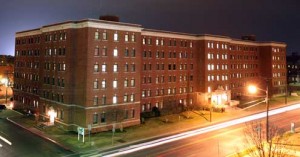
By Nico Zulli
Reporter
It’s a bird. It’s a plane. No, it’s AirBear and now it’s everywhere.
ITS worked with Campus Living and Learning to install AirBear in all residence halls on campus, in an effort to satisfy student demand for wireless Internet access.
“AirBear coverage has been discussed for several years, particularly the idea of extending coverage into residence rooms,” said Scott Day, director of network services. “This discussion began and has continued as a result of feedback from students.”
David Klein, network Group-Edge Team analyst, said in 2003 that Baylor had 300 users on its network. This year, the number of Baylor network users has grown to 16,500 and the amount of devices that access the network are around 32,000.
Klein also said he has noted a 20 percent increase in brand new devices on the network upon return from Christmas break in Jan. 2013.
“Standards are constantly evolving,” Klein said. “And it is our job to try to get hardware out that supports student and faculty use of these devices.”
Originally, the Baylor AirBear Wireless Project was allotted a two-year integration period to install AirBear wireless in Penland, Martin, Kokernot, Allen-Dawson, Alexander-Memorial and Collins residence halls. Day said the time frame was decided based on two key factors.
“I would say the first thing that played a role in the decision on time was a question of how the funding might evolve throughout the project,” he said. “The second thing was the uncertainty of how much and how often we would have access to dorms.”
Bob Hartland, associate vice-president for IT infrastructure, said ITS has seemed limited to working in the summer but was able to complete the AirBear Wireless Project in a matter of months. The project began in the fall 2013 semester and was finished in early spring 2014.
Hartland said the process was significantly sped-up for a couple of reasons.
“A few of us traveled up to the University of New Hampshire to see how they went about implementing wireless into their campus dormitories during the semester months,” he said. “We don’t necessarily try to emulate what other institutions are doing, but we do use peer institutions as a resource to determine what seems to be working.”
In addition to hearing about deployment of wireless network integration from other institutions, Hartland said another aspect that sped-up the process of the project was site surveying.
He said although ITS, Campus-Living and Learning and the Electronic Libraries staff saw the need for this project, funding seemed to be the high hurdle.
“David Klein conducted an extensive site survey and discovered that existing telephone lines could be borrowed for the project, which cut costs down,” Hartland said.
He said Klein then came up with a total costs projection and presented this to Pattie Orr, vice president for information technology and dean of university libraries.
“Pattie got creative and found ways to use existing funds,” Hartland said. “This was then proposed to Campus Living and Learning, and they pitched in a little bit as well.”
Hartland said the cost of the project, which was determined several years prior and based upon technology prices at the time, was approximately $500,000 less once it was actually completed in 2014. The combination of price-reducing factors and the decrease in the price of technology allowed for the lower cost.
The project was carried out with the assistance of Campus Living and Learning, which handled correspondence with students.
“There is very stringent protocol for residence halls,” Hartland said. “None of our technicians are allowed to perform work in the residence halls without an escort, for the purposes of both their safety and the safety of students.”
Day said the wireless network is the overall largest footprint network, with footprint referring to the amount of device usage on the network.
“It didn’t used to be that way,” Day said. “Wireless is something students began requesting in the residence halls, and it is also interesting to see how request for wireless access in the classroom has resulted in professors trying to leverage technology in the classroom as well.”
The only residence hall awaiting AirBear wireless is North Russell Hall, which will receive AirBear along with its current renovation. South Russell Hall is under renovation and will have AirBear available to residents upon opening next fall.
Klein said there were not many reports of dissatisfactory access to the wireless networks in the residence halls once installed, but if one is encountered students are encouraged to seek ITS assistance.
“If anyone has any issues they can contact the help desk, put in a ticket, and I’ll take care of it,” Klein said.
The ITS Help Desk can be reached anytime at 254-710-435, or submit a ticket for assistance on the ITS website.



